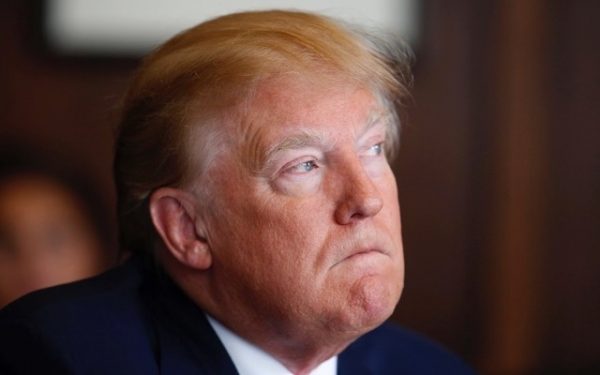
As the two presidential nominees prepare for their final debate Wednesday in Las Vegas, the share of Americans who expect a Hillary Clinton victory is at the highest level since the poll began in July. Among Trump supporters, the share who think he will lose has grown significantly over the last month. That’s contributing to an election that increasingly seems headed to a lopsided finish.
The Daybreak poll asks people whom they plan to vote for and which candidate they expect will win. The question of voter expectations has often, although not always, proved to be a more reliable forecaster of election outcomes than asking voters their candidate preference.
Trump still has many fervent supporters who predict he will win, but, particularly among his voters who are college-educated or in higher-income brackets, expectations for a victory have dimmed.
Their optimism has faded as Trump’s standing in the race against Clinton has declined from a high point in mid-September. The Daybreak poll continues to show a small Trump lead, within the survey’s margin of error, while the other major surveys show Clinton ahead. But the surveys all agree on the trend of declining Trump support.
The descent started after the first presidential debate. Despite what some analysts predicted, the public airing of a videotape in which Trump could be heard boasting that he could get away with assaulting women because of his celebrity did not trigger a meltdown of his poll standing.
In the last few days, his support has shown signs of stabilizing at a lower level. That could mean Trump’s backing has reached a floor, although the evidence is not yet definitive.

In the polling averages, Trump receives support from about 41% of voters in a two-way matchup with Clinton and is a couple of percentage points lower in polls that include third-party candidates. That puts him in the range of lopsided losers including former Vice President Walter F. Mondale, who got 41% and lost 49 states to President Reagan in 1984, and Sen. Barry Goldwater, who took 38% against President Lyndon B. Johnson in 1964’s Democratic landslide.
The country’s partisan division has hardened since those contests, and many more states align solidly with one party or the other. As a result, as the electoral map shows, even a Republican candidate with historically low levels of support can count on winning about 20 states with just short of 160 electoral votes and probably a few more than that. Clinton holds leads in states with 279 electoral votes — more than the 270 needed to win the White House — while five states remain too close to predict.
The decline in Trump’s standing, albeit small, has been enough to bolster Clinton’s edge in the largest of those toss-up states, Florida, where she has led in 10 consecutive polls over the last two weeks. Polling averages show her ahead by about 4 points there. Trump’s decline has also been enough to put at least one traditionally Republican state, Arizona, into the toss-up category.
The declining share of Trump voters who expect a victory could pose further problems for him. Expectations matter to campaign operatives, who try strenuously to project confidence about winning out of concern that voter beliefs about a loss can become self-fulfilling.
If people believe a candidate will lose, they might be discouraged and not turn out to vote, campaign strategists worry. If that happens this year, it could trouble not only Trump but also fellow Republicans, including Senate candidates in close races in such presidential battleground states as New Hampshire, Pennsylvania, North Carolina and Nevada.
Since the Daybreak poll began in July, Clinton has led the voter expectations question. About a month ago, however, after her health suddenly became a campaign issue, her lead on that question shrank to nearly within the poll’s margin of error. Expectations began to shift back again in Clinton’s direction at the end of the month as Trump suffered one political wound after another — many of them self-inflicted.
Currently, 57% of those polled predict a Clinton victory and 38% say Trump will win. That expectation is consistent among all age groups and among both men and women. Those with college educations and those whose family incomes are above $75,000 a year are especially likely to predict a Clinton victory. That reflects, in part, the shift of college-educated Trump supporters toward believing that their candidate will lose.
The rise in expectations of a Clinton victory comes as polls of the race have moved in her direction. Trump’s support dropped about 4 percentage points from the end of September to a low point a few days ago, although it has since rebounded slightly. Currently, the Daybreak poll shows Trump narrowly ahead in voter support, 45% to 43%.
In polling averages, Clinton is ahead by 7 or 8 points. The pattern of a drop of a few points since late September is consistent, however.
The Daybreak poll uses a different methodology than most other surveys, which accounts for much of the difference between its result and that of the average poll.
Pinpointing what triggered Trump’s decline is difficult because so many events have overlapped, starting with the first presidential debate, on Sept. 26, which a large majority of voters felt Clinton won. For much of the week after the debate, Trump quarreled with Alicia Machado, a former Miss Universe who accused him of having publicly shamed her after she gained weight.
An article published by the New York Times on Oct. 2 showing that Trump might have avoided paying federal income taxes for almost two decades appears to have contributed to his slide. The story showed evidence that Trump had claimed a $916 million tax loss in the mid-1990s from the collapse of his casino business. Trump subsequently confirmed that he had used the loss to wipe out his tax liability for years.
Three days after the article was published — about the minimum time for the Daybreak poll to respond to an event — Trump’s support dropped sharply. That could have been a reaction to the tax story although it may also have been in part a delayed reaction to the debate and the subsequent focus on Machado.
Trump’s support continued to drop for the next week. But the Daybreak poll, as well as surveys by the Washington Post and ABC News and SurveyMonkey for NBC News have not shown a big new decline since the “Access Hollywood” video became public and women began publicly accusing Trump of having assaulted them.
One reason for that could be that a large share of voters who support Trump — a majority in many surveys — say their vote is more a ballot against Clinton than one for Trump. Voters motivated by dislike of the opposition may be less likely to shift their positions when confronted with negative information about their own candidate.
Another reason could be Trump’s already low level of support among the groups most likely to be alienated by the charges against him.
In the SurveyMonkey poll, for example, which has an extremely large sample of more than 24,000 likely voters that allows analysis of groups in the electorate, women of all ages supported Clinton. The margins ranged from 35 points among those younger than 30 to six points among those 65 and older.
Among men, the SurveyMonkey poll showed Clinton winning those younger than 45 and college graduates. Trump’s strongest support, as has been true from the start of the campaign, comes from older white men who did not graduate from college — a group whose majority has stuck with him through every controversy.
LA TIMES
Leave a Reply
You must be logged in to post a comment.